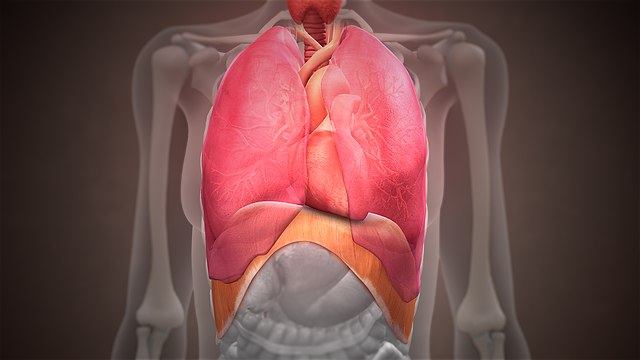
Why do we hiccup? Hiccups are caused by muscular twitches in the diaphragm.
The diaphragm is the muscle that we use to breathe. It is a dome shaped muscle that is below the lungs. It is connected to the sternum at the front, the bottom of the rib cage and the spine, to make a layer across the body that separates the chest from all of the organs below it.
The diaphragm serves two purposes. The first is breathing and the second is helping other organs function. The diaphragm is necessary for breathing, but it is not connected to the lungs and it doesn’t physically pull them down. The diaphragm contracts and expands several times a minute. When you tense the muscle and it contracts, it moves down in the chest and this creates a vacuum in the chest. The lungs expand in the vacuum and air is drawn into them through the nose and mouth. Air always moves from an area of high pressure to an area of low pressure. The high pressure area is outside the body and the low pressure area is in the chest. When you relax your diaphragm, it moves back up in the chest, raising the pressure and the air is expelled.
The second thing the diaphragm does is to help the other organs work. The increased pressure created by the diaphragm helps the bladder and pass urine and helps the bowels work. It also helps the lymphatic system work properly.
There are several things that can go wrong with the diaphragm, but the most common thing that all of us will have experienced at some points is hiccups. We hiccup when the nerves that control the contractions of the diaphragm are triggered and the diaphragm starts to spasm. Every time the diaphragm spasms, air is forcibly sucked into the lungs. The inhalation is so quick that the epiglottis is caught by the suction and slammed shut. The epiglottis is a flap of skin that sits at the back of the throat. It covers the windpipe when we are swallowing food or liquid so that it goes down the correct pipe and we don’t choke. The diaphragm spasm catches the epiglottis, forces it shut, and the sound of the air being cut off is the sound of the hiccup. Someone has actually timed this and it takes 35 milliseconds for the epiglottis to snap shut.
There is no onereason we hiccup and many different things can trigger them. No one actually knows why it happens. The vagus nerve gets stimulated and signals the medulla oblongata part of the brain, which sends a signal to make the diaphragm, contract. What stimulates the nerve and why that causes hiccups is anyone’s guess. Anything can cause it, from breathing suddenly, drinking too much, or even spicy food.
Because the trigger for hiccups is not known, there is no real way of stopping them. All of the methods you have heard about try to interrupt the brain’s signal to the diaphragm or to immobilize the diaphragm. When you drink from the wrong side of a cup or try eating from the wrong side of a plate, you excite different nerves in your mouth and throat which can disrupt the signal to your diaphragm. Although, as most of you know, they don’t really work. Breathing into a paper bag is a good technique because it raises CO2 levels and studies have shown that hiccups tend to stop when CO2 levels rise. Immobilizing the diaphragm by breathing in a lot of air can also work. If you breathe in deeply and then take two more breaths without breathing out, you increase your CO2 levels and you also increase the pressure in your chest, which puts pressure on the diaphragm. Most cases of hiccups tend to go away pretty quickly on their own.
Another diaphragm problem that is similar to hiccups is a runner’s stitch. This is a pain in the side that forms when exercising and it probably comes from the diaphragm. As with hiccups, nobody really knows what causes a stitch as well. It could be a lack of blood supply to the diaphragm. It could be simple spasms in the diaphragm. It could be a stretching of the internal ligaments. It could be friction between layers of tissue inside the abdomen. Nobody really knows. Stopping the exercise, or changing the way you are breathing can fix it. And this is what I learned today.
Image By In source box put https://www.scientificanimations.com – In source box put https://www.scientificanimations.com/wiki-images, CC BY-SA 4.0, https://commons.wikimedia.org/w/index.php?curid=86584916
Sources
https://my.clevelandclinic.org/health/body/21578-diaphragm
https://www.betterhealth.vic.gov.au/health/conditionsandtreatments/hiccups
https://www.verywellhealth.com/what-is-the-diaphragm-2249084
https://www.health.harvard.edu/staying-healthy/stopping-hiccups
https://www.webmd.com/fitness-exercise/what-to-know-about-a-side-stitch
